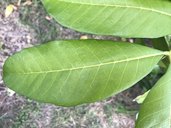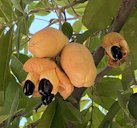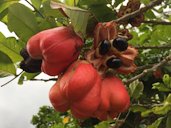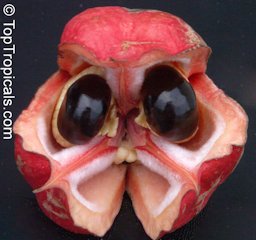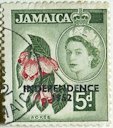| Ackee - Blighia sapita | |||||||||||||||||||||
|---|---|---|---|---|---|---|---|---|---|---|---|---|---|---|---|---|---|---|---|---|---|
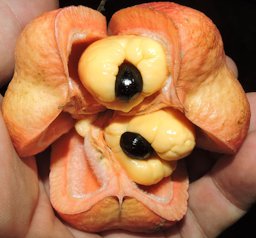 Fig. 1 Blighia sapida (cultivado) 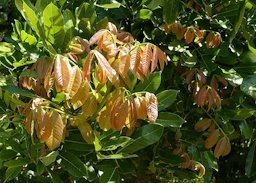 Fig. 2  Plant specimen in the Fruit and Spice Park, Homestead, Florida, USA 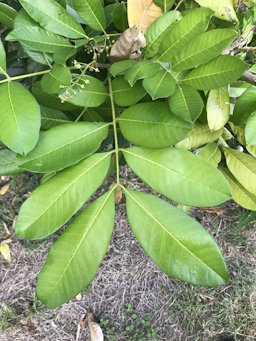 Fig. 3  Ackee, B. sapida, Cuba 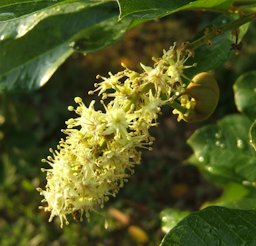 Fig. 6  Inflorescence 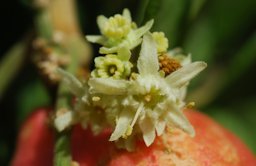 Fig. 7  B. sapida, Burkina Faso, Dano, Dreyer Foundation 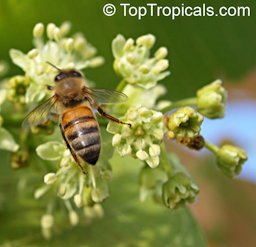 Fig. 8  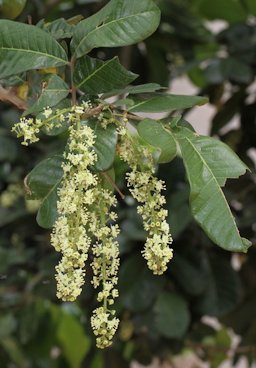 Fig.9   Fig. 10   Fig. 11 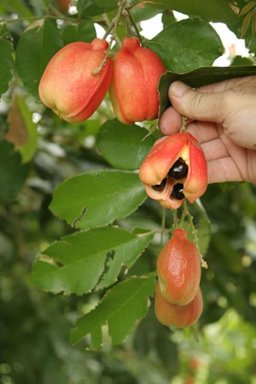 Fig. 18  Non-mature (closed) ackee fruit and naturally split (awned) ackee fruit on the tree  Fig. 19  Fruiting habit, Ackee, Benin, Africa 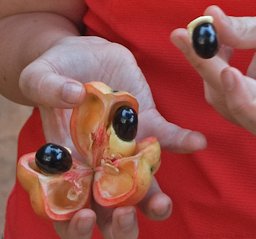 Fig. 20  Showing ripe akee fruit and seeds, two of the three seeds with their arils still in place 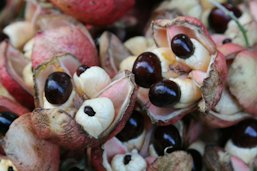 Fig. 21  Portions of this ripe fruit are safe to eat, but only after some careful prep work 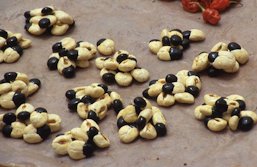 Fig. 22  B. sapida, Côte d'Ivoire, Katiola 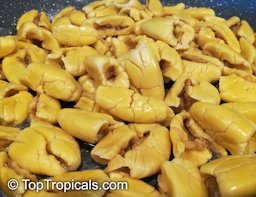 Fig. 23  Fig. 24  Plant specimen in the Fruit and Spice Park, Homestead, Florida, USA  Fig. 25  Ackee, B. sapida, Benin, Africa  Fig. 26  Ackee, Benin, Africa 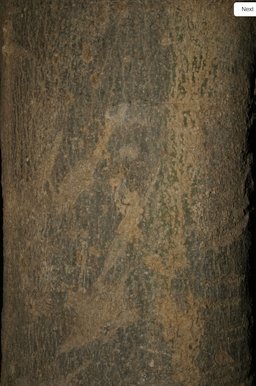 Fig. 27 B. sapida, Mali, Savane de Woroni, West Africa 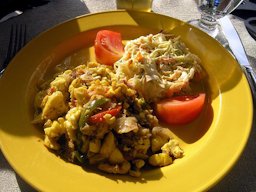 Fig. 28  Ackee and saltfish, a traditional Jamaican dish |
Scientific
name Blighia sapita K.D.Koenig Common names English: ackee, akee, akee apple, aki, savory akee tree, vegetable brain; French: akée, fisanier, arbre fricassee, blighia savoureuse, fausse anacarde, pommier d’aki, ris de veau végéta; German: Akibaum, Aki-P flaume; Portuguese: castanha, castanheiro-da-África; Spanish: akí, arbol fe seso, huevo vegetal, seso vegetal; Swedish: aki 1,2 Synonyms Akea solitaria Stokes; Akeesia africana Tussac; Bonannia nitida Raf.; Cupania akeesia Cambess. ex Spach; C. edulis Schumach. & Thonn.; C. sapida (K.D.Koenig) Oken; Sapindus obovatus Wight & Arn. 8,13 Relatives Lychee (Litchi chinensis), longan (Dimocarpus longan), mamoncillo (Melicoccus bijugatus), rambutan (Nephelium lappaceum), pulasan (N. mutabile) Family Sapindaceae (soapberry family) Origin Ivory Coast and Gold Coast of West tropical Africa 5 USDA hardiness zones 10-12 12 Uses Food; medicine; ornamental; shade Height 30-75 ft (9-23 m) 5 Crown Rounded to oval shaped canopy; dense crown of stiff spreading branches 3,5 Trunk/bark/branches Bark is gray and nearly smooth; ribbed branchlets 3,6 Pruning requirement Maintain the height for ease of harvest Leaves Evergreen; alternate pinnate (compound) leaves; 6-8 leaflets with short petioles; shiny green, stiff; 6-8 in. (15–20 cm) long 5 Flowers White; aromatic; bisexual and male flowers borne together on simple racemes; blooms 1-3 times/year 5 Fruit Pear-shaped; red to yellow-orange; split open when mature; three large, shiny black seeds; fleshy, ivory-colored aril 11 Season Aug.-Mar. 4 Light requirement Full fun Soil tolerances Does very well on oolitic limestone and on sand in southern Florida; grows faster in more fertile soils 3 pH preference 5.5-6.5 7 Drought tolerance Although drought-tolerant, it should be watered during our spring dry season Cold tolerance Mature plants can be killed at 26 °F (-3 °C) 7 Plant spacings 25-30 ft (6.7-7.6 m) 5 Roots Extensive root system Invasive potential * None reported Pest/disease resistance Few pests/diseases in Florida at the present time 5 Known hazard All parts of the immature (unripe) or overripe fruit are highly poisonous (hypoglycin A and B toxin) 5 Reading Material Ackee Growing in the Florida Home Landscape, University of Florida pdf Akee, Fruits of Warm Climates Blighia sapida Record, PROTA4U The Akee: A Fruit Where Timing is Everything, Tropical Fruit News RFCI Akee: Deadly and Delicious, Tropical Fruit News RFCI Recommendation from UF/IFAS: Although the foliage and bright red fruit of ackee are beautiful, they are not recommended for home plantings by anyone unfamiliar with the fruit of this tree. In addition, children and adults unfamiliar with the fruit must be kept from consuming the fruit if it is accidentally picked at an improper stage of development. This publication is intended to educate the general public on this fruit and provide cultural information to those intimately familiar with this fruit. This publication is not an endorsement for planting ackee in the home landscape. 5 Origin The akee is indigenous to the forests of the Ivory Coast and Gold Coast of West tropical Africa. It is now widespread in tropical and subtropical environments and is the national fruit of Jamaica. It has also been introduced into Australia. 1 Sapindaceous Fruits and Nuts, West Australian Nut and Tree Crop Association Description The ackee (Blighia sapida), a tropical fruit belonging to the Sapindaceae family, has its origin in West Africa but has traversed the Atlantic Ocean, making the Caribbean (where it grows wildly and is also cultivated) its home. 10 Blighia comprises 3 species and originates from tropical Africa. Blighia sapida can be distinguished from the other two species by its large fruits with rounded lobes. 14 In Jamaica, two types of ackee are recognized – ‘cheese’, or hard, and ‘butter’, or soft. The ‘cheese’ ackee aril is hard, cream coloured and retains its shape when cooked, while the ‘butter’ ackee aril is soft and yellow, losing its shape easily during cooking. 10 The colloquial name Ackee is derived from the terms ‘anke’ and ‘akye-fufuo’, which are used to describe the fruit in West Africa. The scientific name honours Captain William Bligh who took the fruit from Jamaica to the Royal Botanic Gardens in Kew, England in 1793. 3,10 The plant has been known to escape from cultivation when grown in sandy soils. 8 Leaves The evergreen (rarely deciduous), alternate leaves are compound with 3 to 5 pairs of oblong, obovate-oblong, or elliptic leaflets, 6 to 12 in (15-30 cm) long, rounded at the base, short-pointed at the apex; bright-green and glossy on the upper surface, dull and paler and finely hairy on the veins on the under side. 3
Fig. 4. Ackee, B. sapida, Cuba Fig. 5. Three leaves of akee, two showing upper surface, one showing underside Flowers The ackee flowers from pseudoterminal shoots, in other words, flowering looks to be terminal, but in fact, new shoot growth continues from the area next to the lateral raceme. Bisexual and male flowers are borne together on simple racemes, 3 to 7 inches (7.5–17.5 cm) long. The white flowers have 5 sepals, 5 petals, and a nectary disc at the base from which 1 to 8 stamens are attached and a superior ovary with 3 stigmas. 5 In Jamaica, Cuba, Florida, and perhaps other tropical locations, B. sapida flowers and fruits twice a year. Flowering occurs generally from March to June and from September to November. The heaviest crop is harvested during the summer. In some areas, the trees may produce flowers and fruits year-round. 5 Pollination Ackee is insect pollinated. 5 Fruit The fruit is a leathery, pear shaped, more or less distinctly 3-lobed capsule 2 3/4 to 4 in (7-10 cm) long; basically yellow, more or less flushed with bright-scarlet. When it is fully mature, it splits open (commonly called awned) revealing 3 cream-colored, fleshy, glossy arils, crisp, somewhat nutty-flavored, attached to the large, black, nearly round, smooth, hard, shining seeds–nonnally 3; often 1 or 2 may be aborted. The base of each aril is attached to the inside of the stem-end of the "jacket" by pink or orange-red membranes. 3 The fleshy substance (technically the arillus), resembles in appearance the brain of a small animal. It is firm and oily in texture, and has a somewhat nutty flavor. 15 Most of the photosynthate energy stored in the fruit (aril) is in the form of lipids, similar to avocados and olives; healthy unsaturated fatty acids predominate. 16 Fruit development takes 50–60 days from fruit set to open capsule stage 2.5- 5.3 oz (70–150 g) final weight, with fruit doubling in size during the first 14–21 days. 9 Harvest is staged, a positive feature for home-growers. 16
Fig. 12. Ackee, Port-au-Prince, Haiti Fig. 13. B. sapida, Manchester, Jamaica Fig. 16. Part of ripe fruit, two seeds with their arils still attached Fig. 17. Ripe akee seeds with their arils, one whole (dorsal view), one in longitudinal section Toxicity The toxicity of the akee was long misunderstood and believed to reside in the membranes attaching the arils to the jacket, or only in the overripe and decomposing arils. There have been intensive clinical and chemical studies of the akee and its effects since 1940, and it is now known that the unripe arils contain hypoglycin, a-amino-B-(2-methylenecyclopropyl) propionic acid, formerly called hy poglycin A. This toxic property is largely dispelled by light as the jacket opens. When fully ripe, the arils still possess 1/12 of the amount in the unripe. The seeds are always poisonous. 3 Varieties There are a number of locally recognized types of ackee: regular (moderate pulp hardness); hard (hard pulp); and soft, sometimes call butter ackee. Other selections are called "cheese." These have more flesh around the seed, and the pulp has a smooth texture. They are considered superior to the more common forms. 5 Harvesting Ackee fruit are harvested after the fruit has split longitudinally. The flesh of the ackee aril is only edible and nonpoisonous after the fruit capsule has split naturally and the flesh is firm. 5 Arils for fresh consumption should be picked from dehisced fruits, which ensures that the seeds and arils are fully ripe and that arils do not contain serious amounts of toxin. Another appropriate method is to collect unopened but ripe fruits from the tree and lay them on racks in the sun. Arils can be harvested from the fruits when they have opened after about 3 days. 14 In Florida, a tree may produce 100-150 pds (45–68 kg) of fruits per year. 14 Propagation In Florida, seeds are sown in germination boxes and germination is said to take normally 2–3 months. 14 Cuttings are effective as a means of vegetative propagation and quickly produce roots if planted under the right conditions. Grafting and air layering have also been used as alternative methods to propagate this species. 6 The tree begins to bear in 3–4 years from seed and 1–2 years by vegetative propagation. 9 In Florida, trees raised from seedlings start producing fruit after 3–6 years, while grafted trees produce fruit in 1–2 years. 14 Pruning The tree exhibits vigorous growth and pruning is recommended. 9 Formative pruning during the first 2 years may be desirable to encourage lateral branching and growth. After several years of production, it is desirable to cut back the tops of the trees to 12 to 15 feet (3.6–4.6 m). 5 Trees often sprout vigorously from stumps. 14 Fertilizing In Florida and other regions where Blighia sapida is planted for commercial fruit production, young trees are fertilized every 1–2 months during the first year. 14 Thereafter, 3 or 4 applications per year in amounts proportionate to the increasing size of the tree are sufficient, but do not exceed 20 lb per tree per year. 5 From spring through summer, trees should receive 2 to 3 annual nutritional sprays of copper, zinc, manganese, and boron for the first 4 to 5 years. Ackee trees are susceptible to iron deficiency under alkaline and high-pH soil conditions. Iron deficiency can be prevented or corrected by periodic soil applications of iron chelates formulated for alkaline and high-soil-pH conditions. Periodic applications of ferrous (iron) sulfate may be made to trees growing in low-pH soils. 5 Irrigation Newly planted ackee trees should be watered at planting and every other day for the first week or so and then 1 to 2 times a week for the first couple of months. During prolonged dry periods (e.g., 5 or more days of little to no rainfall) newly planted and young ackee trees (first 3 years) should be well watered twice a week. Once the rainy season arrives, irrigation may be reduced or stopped. 5 Pests/Diseases In Florida, an attack by Verticillium dahliae has been recorded, causing wilt and dieback. In Jamaica, stem galls are common. 14 Food Uses The akee fruit must be allowed to open fully (ripe) before it is detached from the tree. The fleshy arils from fully ripe fruits are eaten fresh or used for many dishes after parboiling, cooking or frying. Arils of the ripe fruit are nutty- flavoured, and cooked arils have texture of scrambled eggs. The seeds are discarded and the arils, while still fresh and firm are best parboiled in salted water or milk and then lightly fried in butter. 2 The pink raphe that attaches the aril to its seed is deadly toxic and must be carefully and completely removed. 8 The only edible part of the fruit, the aril, is fried with seasonings or in pastry. In preparation, the aril is usually first cooked by boiling in salt water and this water discarded. The popular ‘Ackee and saltfish’ is Jamaica’s national dish and one of the island’s culinary delicacies. In West Africa, the aril is eaten raw, fried or roasted. 5 Harvested correctly and prepared properly, the akee is a nutritious vegetable rich in essential fatty acids, vitamin A, and protein. It is a major ingredient in West African and Jamaican cuisine. 11 Jamaican Produce Vendor (preparing the fruit for consumption)
Medicinal Properties ** In Brazil, repeated small doses of an aqueous extract of the seed has been administered to expel parasites. The treatment is followed by a saline or oily purative. Cubans blend the ripe arils with sugar and cinnamon and give the mixture as a febrifuge and as a treatment for dysentery. On the Ivory Coast, the bark is mixed with pungent spices in an ointment applied to relieve pain. The crushed new foliage is applied on the forehead to relieve severe headache. The leaves, crushed with salt, are poulticed on ulcers. The leaf juice is employed as eye drops in ophthalmia and conjunctivitis. In Colombia, the leaves and bark are considered stomachic. Various preparations are made for treatment of epilepsy and yellow fever. 3 Other Uses The heartwood is reddish-brown, hard, coarse-grained, durable and immune to termites. It is used locally for light construction and pilings, building materials, carpentry and related applications, farming, forestry, hunting and fishing apparatus and has been recommended for railway sleepers. It is also fashioned into boxes, oars, tool handles, mortars, handicraft, carvings, paddles and casks. In the timber trade, the wood is marketed as achin or tsana. The wood is also used for fuel and lighting. 2 The purified oil from the fruit has high nutritive value and makes an important contribution to the fatty acid intake of many Jamaicans and West Africans. 6 The rind contains saporin and may be used to poison fish so that they will be rendered easier to catch. The ash obtained from dried husks and seeds, is used for soap making in West Africa. Fruits have the property of producing saponin, which lather in water and are used for washing. 6 In Cuba, volatiles are extracted from flowers and used in making perfume and appreciated as cologne. 10 An ink for tattoos is made from the seeds. 14 General While its popularity has never faltered, the fruit killed around five thousand Jamaicans between 1886 and 1950. Consumers of the unripe fruit sometimes suffer from 'Jamaican vomiting sickness syndrome' (JVS) allegedly caused by the unusual amino acid components, hypoglycin A and B. Levels of hypoglycin A in the arilli peak at maturity but rapidly diminish to non-detectable levels in the opened fruit making it safe for consumption. Although JVS has resulted in some fatalities in the past with symptoms including vomiting and severe hypoglycaemia, nowadays such incidences are rare with the increased awareness of the necessity for consuming only ripe, opened fruits. 6 The canned arils of ackee fruit are a major export product from Jamaica. In 2005 the ackee industry on the island was valued at J$ 400 million (c. US$ 6.5 million). The importing of canned ackee into the USA has at times been restricted due to unripe ackee arils being included. However, it is currently allowed, provided that the amount of hypoglycine A present meets the standards of the FDA. Jamaica seeks to find a niche in growing exotic foods such as the savoury ackee fruit to market in the USA and continues to export ackee to the United Kingdom and Canada, where there are large communities of Jamaicans. 10 The ackee is prominently featured in the Jamaican mento style folksong "Linstead Market". In the song, a market seller laments, "Carry mi ackee go a Linstead market. Not a quattie worth sell". Ackee is the national fruit of Jamaica. Ackee and saltfish is Jamaica’s national dish. Jamaicans are among the only people in the world today who actually eat this fruit on a regular basis. 12
Further Reading Blighia sapida, Encyclopedia of Life The Akee, Manual Of Tropical And Subtropical Fruits List of Growers and Vendors |
||||||||||||||||||||
| Bibliography 1 "Taxon: Blighia sapida K. D. Koenig." USDA, Agricultural Research Service, U.S. National Plant Germplasm System, GRIN-Global, npgsweb.ars-grin.gov/gringlobal/taxon/taxonomydetail?id=7271. Accessed 14 Sept. 2021. 2 Lim, T. K. "Edible medicinal and non-medicinal plants, Fruits, vol. 6." ZLibrary, 2013, b-ok.cc/book/2144921/a9ea16. Accessed 14 Sept. 2021. 3 Fruits of Warm Climates. Julia F. Morton. Miami, 1987. 4 Crane, Jonathan H, and Carlos F. Balerdi. "Estimated commercial subtropical and tropical fruit crop harvest seasons in Florida." UF/IFAS,Tropical Research and Education Center, AskIFAS, sfyl.ifas.ufl.edu/media/sfylifasufledu/miami-dade/documents/tropical-fruit/Tropical-Fruit-seasons-in-Florida.pdf. Accessed 14 Sept. 2021. 5 Crane, Jonathan H, et al. "Ackee Growing in the Florida Home Landscape." Horticultural Sciences Dept., UF/IFAS Extension, HS1128, Original pub. Jan. 2008., Revised Dec. 2017 and Dec. 2020, AskIFAS, edis.ifas.ufl.edu/publication/HS378. Accessed 15 Sept. 2021. 6 "Blighia sapida Koenig." Agroforestry Tree Species, IGRAF Database, db.worldagroforestry.org/species/properties/Blighia_sapida. Accessed 15 Sept. 2021. 7 Fern, Ken. "Blighia sapida." Ecocrop, Tropical Plants Database, tropical.theferns.info/viewtropical.php?id=Blighia+sapida. Accessed 15 Sept. 2021. 8 Barwick, Margaret. Tropical & Subtropical Trees. A Worldwide Encyclopaedic Guide, London, 2004. 9 The Encyclopedia of Fruit & Nuts. Edited by Jules Janick and Robert E. Paull, Cambridge, CABI, 2008. 10 Yahia, Elhadi M. "Ackee fruit (Blighia sapida Konig)." Postharvest Biology and Technology of Tropical and Subtropical Fruits: Volume 2: Acai to Citrus, 2011, ZLibrary, b-ok.cc/book/1221799/a56d2f?dsource=recommend. Accessed 23 Sept. 2021. 11 Blancke, Rolf. "Tropical Fruits and Other Edible Plants of the World: An Illustrated Guide." Zlibrary, 2016, b-ok.cc/book/3414166/f1bf9d?dsource=recommend. Accessed 23 Sept. 2021. 12 "Blighia sapida." Missouri Botanical Garden, www.missouribotanicalgarden.org/PlantFinder/PlantFinderDetails.aspx?taxonid=286811. Accessed 28 Sept. 2021. 13 "Blighia sapida K.D.Koenig, synonyms." Plants of the World Online, Facilitated by the Royal Botanic Gardens, Kew, POWO, (CC BY 3.0), powo.science.kew.org/taxon/urn:lsid:ipni.org:names:782152-1. Accessed 28 Sept. 2021 14 Asamoah, A., et al. "Blighia sapida K.D.Koenig." Record from PROTA4U, Edited by R. H. M. J. Lemmens, D. Louppe, and A. A. Oteng-Amoako, PROTA (Plant Resources of Tropical Africa, Ressources végétales de l’Afrique tropicale), Wageningen, Netherlands, 2010, (CC BY-NC-SA 3.0), prota4u.org/database/protav8.asp?h=M4&t=Blighia,sapida&p=Blighia+sapida#Synonyms. Accessed 29 Sept. 2021. 15 Popenoe, Wilson. Manual Of Tropical And Subtropical Fruits. 1920, London, Hafner Press, 1974. 16 "Ackee, Akee, Aki, Blighia sapida." The Rare Fruit Club WA, rarefruitclub.org.au/Ackee.htm. Accessed 30 Sept. 2021. Video v1 "Ackee Fruit: Trying the Notoriously Delicious Fruit in Jamaica (& Susumba Fruit Review + Recipe)." Weird Explorer, 5 Feb. 2020, (CC0), www.youtube.com/watch?v=fS_spm79C5E. Accessed 30 Sept. 2021. Photographs Fig. 1 Aguilar, Reinaldo. "Blighia sapida K.D. Koenig (cultivado)." Vascular Plants of the Osa Peninsula, Costa Rica, ID 16376106480, EOL, (CC BY-NC-SA 2.0), Image cropped, eol.org/media/6634294. Accessed 23 Sept. 2021. Fig. 2 Daderot. "Plant specimen in the Fruit and Spice Park, Homestead, Florida, USA." Wikimedia Commons, 16 Mar. 2017, Puclic Domain, commons.wikimedia.org/wiki/File:Blighia_sapida_-_Fruit_and_Spice_Park_-_Homestead,_Florida_-_DSC09016.jpg. Accessed 15 Sept. 2021. Fig. 3,4 Fidler, Wayne. "Ackee, Blighia sapida, Cuba." iNaturalist, Research Grade, 31 Jan. 2018, (CC BY-NC 4.0), www.inaturalist.org/observations/9679614. Accessed 25 Sept. 2021. Fig. 5 Schuiling, Rik. " Three leaves of akee, two showing upper surface, one showing underside (Bobo-Dioulasso, Burkina Faso nov2013)." Tropical Crops Services, 14 Nov.2013, Wikimedia Commons, (CC BY-SA 3.0), commons.wikimedia.org/wiki/File:2013.11-411-172 Akee,leaves(e-s) Bobo-Dioulasso,BF thu14nov2013-1025h.jpg. Accessed 14 Sept. 2021. Fig. 6 Walker, Jerome. "Inflorescense." Wikimedia Commons, 29 May 2006, (CC BY-SA 2.5), commons.wikimedia.org/wiki/File:Ackee_Flower_001.JPG3. Accessed 14 Sept. 2021. Fig. 7 Porembski, Stefan. "Blighia sapida K.D.Koenig, Burkina Faso, Dano, Dreyer Foundation." West African plants - A Photo Guide, Brunken, U., et al, 2008, Forschungsinstitut Senckenberg, Frankfurt/Main, Germany, ID 31770, 8 Apr. 2013, www.westafricanplants.senckenberg.de. Accessed 25 Sept. 2021. Fig. 8 "Blighia sapida." Top Tropicals, toptropicals.com/pics/garden/07/6/P7236992.jpg. Accessed 15 Sept. 2021. Fig. 9 Mangelsdorff, Ralph. "Blighia sapida K.D.Koenig, Benin, Pobé forest." West African plants - A Photo Guide, Brunken, U., et al, 2008, Forschungsinstitut Senckenberg, Frankfurt/Main, Germany, ID 76252, 27 Aug. 2015, www.westafricanplants.senckenberg.de. Accessed 25 Sept. 2021. Fig. 10 "Blighia sapida." Top Tropicals, toptropicals.com/cgi-bin/garden_catalog/cat.cgi?uid=Blighia_sapida. Accessed 15 Sept. 2021. Fig. 11 Khaytarova, Marina. "Blighia sapida." Top Tropicals, toptropicals.com/cgi-bin/garden_catalog/cat.cgi?uid=Blighia_sapida. Accessed 15 Sept. 2021 Fig. 12 tswartzlander. "Ackee, Blighia sapida, Port-au-Prince, Haiti." iNaturalist, Research Grade, 20 Jan. 2020, (CC0), Image cropped, www.inaturalist.org/observations/37794684. Accessed 25 Sept. 2021. Fig. 13 Gleissberg, Stefan. "Ackee, Blighia sapida, Manchester, Jamaica." iNaturalist, Research Grade, 21 Nov. 2017, (CC BY-NC 4.0), www.inaturalist.org/observations/8893199. Accessed 25 Sept. 2021. Fig. 14 Cerlin Ng. "Ackee, Blighia sapida." Flickr, 22 Nov. 2016, (CC BY-NC-SA 2.0), www.flickr.com/photos/89906643@N06/39468788721/. Accessed 29 Sept. 2021. Fig. 15 "Blighia sapida." Top Tropicals, toptropicals.com/pics/garden/07/km/PICT0152.jpg. Accessed 15 Sept. 2021. Fig. 16 Schuiling, Rik. "Part of ripe fruit, two seeds with their arils still attached (Bobo-Dioulasso, Burkina Faso nov2013)." Tropical Crops Services, 14 Nov.2013, Wikimedia Commons, (CC BY-SA 3.0), commons.wikimedia.org/wiki/File:2013.11-411-169_Akee,fruit(part),seed%26aril(i-s)_Bobo-Dioulasso,BF_thu14nov2013-0953h.jpg. Accessed 14 Sept. 2021. Fig. 17 Schuiling, Rik. "Ripe akee seeds with their arils, one whole (dorsal view), one in longitudinal section (Bobo-Dioulasso, Burkina Faso nov2013)." Tropical Crops Services, 14 Nov.2013, Wikimedia Commons, (CC BY-SA 3.0), commons.wikimedia.org/wiki/File:2013.11-411-169_Akee,seed%26aril(whole,LS)_Bobo-Dioulasso,BF_thu14nov2013-0953. Accessed 14 Sept. 2021. Fig. 18 Brown,Stephen. "Non-mature (closed) ackee fruit and naturally split (awned) ackee fruit on the tree." Ackee Growing in the Florida Home Landscape, Horticultural Sciences Dept., UF/IFAS Extension, HS1128, Original pub. Jan. 2008., Revised Dec. 2017 and Dec. 2020, AskIFAS, edis.ifas.ufl.edu/publication/HS378. Accessed 15 Sept. 2021. Fig. 19 ONG OeBenin. "Ackee, Blighia sapida, Benin, Africa." iNaturalist, Research Grade, 10 Oct. 2020, (CC BY-NC 4.0), www.inaturalist.org/observations/62222199. Accessed 29 Sept. 2021. Fig. 20 Schuiling, Rik. "Showing ripe akee fruit and seeds, two of the three seeds with their arils still in place (Bobo-Dioulasso, Burkina Faso nov2013)." Tropical Crops Services, 10 Nov.2013, Wikimedia Commons, (CC BY-SA 3.0), commons.wikimedia.org/wiki/File:2013.11-411-155 Akee,fruit(e-s),seed&aril Bobo-Dioulasso,BF sun10nov2013-1740h.jpg. Accessed 28 Sept. 2021. Fig. 21 Cook, Dave. "Jamaican produce vendor." Eating in Translation Blog, 11 Aug. 2010, (CC BY-NC-ND 3.0 US), www.eatingintranslation.com/2010/08/jamaican-produce-vendor.html. Accessed 25 Sept. 2021. Fig. 22 Neumann, Katharina. "Blighia sapida K.D.Koenig, Côte d'Ivoire, Katiola." West African plants - A Photo Guide, Brunken, U., et al, 2008, Forschungsinstitut Senckenberg, Frankfurt/Main, Germany, ID 8180, www.westafricanplants.senckenberg.de. Accessed 25 Sept. 2021. Fig. 23 "Blighia sapida." Top Tropicals, toptropicals.com. Accessed 15 Sept. 2021. Fig. 24 Daderot. "Plant specimen in the Fruit and Spice Park, Homestead, Florida, USA." Wikimedia Commons, 3 Feb. 2017, Puclic Domain, Image cropped, commons.wikimedia.org/wiki/File:Blighia_sapida_-_Fruit_and_Spice_Park_-_Homestead,_Florida_-_DSC09014.jpg. Accessed 15 Sept. 2021. Fig. 25 didolanvijustin. "Ackee, Blighia sapida, Benin, Africa." iNaturalist, Research Grade, 6 Aug. 2019, (CC BY-NC 4.0), www.inaturalist.org/observations/30348741. Accessed 25 Sept. 2021. Fig. 26 didolanvijustin. "Ackee, Blighia sapida, Benin, Africa." iNaturalist, Research Grade, 25 June 2019, (CC BY-NC 4.0), www.inaturalist.org/observations/27642648. Accessed 25 Sept. 2021. Fig. 27 Birnbaum, Philippe. "Blighia sapida K.D.Koenig, Mali, Savane de Woroni." West African plants - A Photo Guide, Brunken, U., et al, 2008, Forschungsinstitut Senckenberg, Frankfurt/Main, Germany, ID 12196, 13 Feb. 2009, Image cropped, www.westafricanplants.senckenberg.de. Accessed 25 Sept. 2021. Fig. 28 gailf548. "Ackee and saltfish, a traditional Jamaican dish." Wikimedia Commons, 3 Feb. 2017, (CC BY 2.0), commons.wikimedia.org/wiki/File:Ackee_and_Saltfish.jpg. Accessed 15 Sept. 2021. Fig. 29 Morgan, Mark. "Jamaica Ackee." Flickr, 15 June 2915, (CC BY 2.0), www.flickr.com/photos/mmorgan8186/18946108830/. Accessed 15 Sept. 2021. * UF/IFAS Assessment of Non-native Plants in Florida's Natural Areas ** Information provided is not intended to be used as a guide for treatment of medical conditions. Published 30 Sept. 2021 LR |
|||||||||||||||||||||
